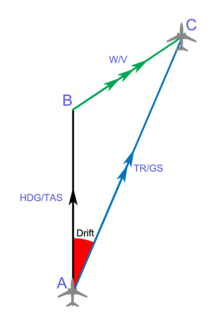Heading (navigation)
Appearance

Heading is a term used in navigation that refers to the direction a vehicle is pointing. This may or may not be the direction that the vehicle actually travels, which is known as its course or track. Any difference between course and heading is due to the motion of the underlying medium, the air or water, or other effects like skidding or slipping. The difference between heading and course is known as drift, and can be determined by the navigational triangle.
Notation
Heading is typically based on compass directions, so 0° (or 360°) indicates a direction toward true North, 90° indicates a direction toward true East, 180° is true South, and 270° is true West.
